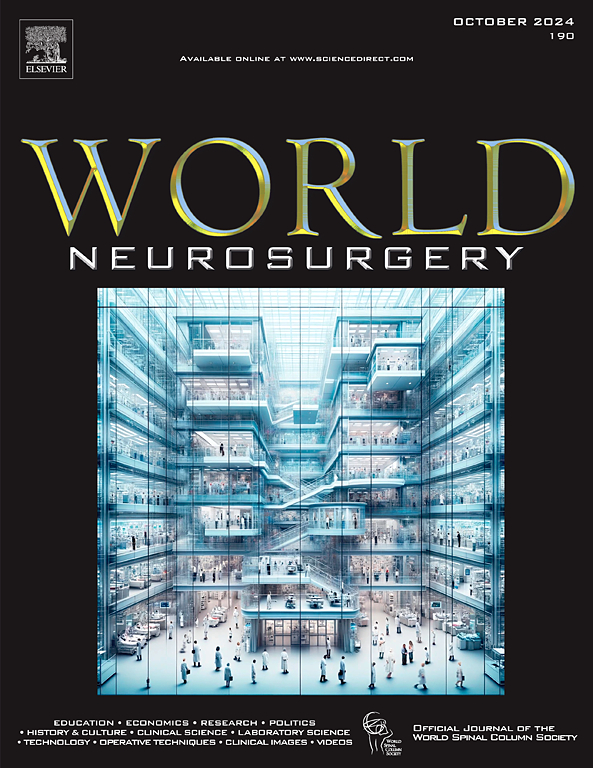基于深度学习的脑积水脑室分割模型:系统回顾和荟萃分析。
IF 1.9
4区 医学
Q3 CLINICAL NEUROLOGY
引用次数: 0
摘要
背景:脑室分割是神经影像学资料评估的关键步骤,尤其是脑积水。目前的方法主要基于二维测量和比例。传统的手动和半自动心室分割耗时长,且在处理大量放射学特征时缺乏灵活性。最近,深度学习(DL)模型已经被开发出来进行心室分割,并显示出有希望的结果。本研究的目的是评估基于dl的脑积水模型在脑室分割中的性能。方法:于2024年12月5日,在Pubmed、Embase、Scopus和Web of Science四个电子数据库中,采用个性化检索查询进行系统检索。纳入了基于dl的脑积水患者心室分割模型的平均骰子相似系数(DSC)的研究。提取最佳性能模型的平均DSC。结果:纳入24项研究,共2911例患者。最佳性能模型的平均DSC范围为0.671至0.99。荟萃分析显示,合并平均DSC为0.89 (95%CI: 0.84-92)。亚组分析得出基于磁共振成像(MRI)的模型的总平均DSC为0.88 (95%CI: 0.80-0.96),基于计算机断层扫描(CT)的模型为0.91 (95%CI: 0.86-0.95),基于超声(US)的最佳性能基于dl的模型为0.84 (95%CI: 0.81-0.87)。结论:基于dl的脑积水模型在脑室分割方面显示出良好的效果。将这些模型应用于临床实践,可以优化脑积水患者的治疗方案,提高临床疗效。本文章由计算机程序翻译,如有差异,请以英文原文为准。
Deep Learning-Based Models for Ventricular Segmentation in Hydrocephalus: A Systematic Review and Meta-Analysis
Background
Ventricular segmentation is a critical step in neuroimaging data evaluation, particularly in hydrocephalus. Current methods are mainly based on 2-dimensional measurements and ratios. Traditional manual and semiautomatic ventricular segmentation are time-consuming, operator-based, and lack flexibility in handling numerous radiological features. Recently, deep learning (DL) models have been developed to perform ventricular segmentation and have shown promising outcomes. The objective of the current study was to evaluate the performance of DL-based models in ventricular segmentation in the hydrocephalus setting.
Methods
On December 5, 2024, a systematic search was conducted using an individualized search query in 4 electronic databases: PubMed, Embase, Scopus, and Web of Science. Studies that reported the mean dice similarity coefficient (DSC) of DL-based models in ventricular segmentation in patients with hydrocephalus were included. The mean DSC for the best-performance model was extracted.
Results
Twenty-four studies with 2911 patients were included. The mean DSC ranged from 0.671 to 0.99 across the best-performance models. The meta-analysis revealed a pooled mean DSC of 0.89 (95% CI: 0.84–92). The subgroup analysis yielded a pooled mean DSC of 0.88 (95% CI: 0.80–0.96) for magnetic resonance imaging-based models, 0.91 (95% CI: 0.86–0.95) for computed tomography-based models, and 0.84 (95% CI: 0.81–0.87) for ultrasound-based best-performance DL-based models.
Conclusions
DL-based models have demonstrated favorable outcomes in ventricular segmentation in patients with hydrocephalus. Application of these models in clinical practice can optimize the treatment protocol and enhance the clinical outcomes of hydrocephalus patients.
求助全文
通过发布文献求助,成功后即可免费获取论文全文。
去求助
来源期刊

World neurosurgery
CLINICAL NEUROLOGY-SURGERY
CiteScore
3.90
自引率
15.00%
发文量
1765
审稿时长
47 days
期刊介绍:
World Neurosurgery has an open access mirror journal World Neurosurgery: X, sharing the same aims and scope, editorial team, submission system and rigorous peer review.
The journal''s mission is to:
-To provide a first-class international forum and a 2-way conduit for dialogue that is relevant to neurosurgeons and providers who care for neurosurgery patients. The categories of the exchanged information include clinical and basic science, as well as global information that provide social, political, educational, economic, cultural or societal insights and knowledge that are of significance and relevance to worldwide neurosurgery patient care.
-To act as a primary intellectual catalyst for the stimulation of creativity, the creation of new knowledge, and the enhancement of quality neurosurgical care worldwide.
-To provide a forum for communication that enriches the lives of all neurosurgeons and their colleagues; and, in so doing, enriches the lives of their patients.
Topics to be addressed in World Neurosurgery include: EDUCATION, ECONOMICS, RESEARCH, POLITICS, HISTORY, CULTURE, CLINICAL SCIENCE, LABORATORY SCIENCE, TECHNOLOGY, OPERATIVE TECHNIQUES, CLINICAL IMAGES, VIDEOS
 求助内容:
求助内容: 应助结果提醒方式:
应助结果提醒方式:


